What is Beltane? Do Christians observe it? Some churches are having a fire on the beach at dawn on May 1
Beltane is not a Christian festival. It is rooted in the cultural observance of the Celtic countries of Ireland and Scotland and the Isle of Man and is attested in old Irish literature. One etymology of Beltaine could derive from the Celtic belo-te(p)niâ, meaning “bright fire.” Some have suggested that Bel was the ancient Celtic sun god.
Beltane was clearly a fertility festival. Some aspects of the pagan fertility rites were suppressed by Christianity, although traditions lingered on in the Celtic folk culture and were “baptized” by the church. There has been an interest in Celtic spirituality and the Beltane festival is a part of it. The central feature of the festival was a huge bonfire which was intended to ward off demons and evil spirits. Participants sprinkled ashes from the fire on themselves, their crops, and their livestock. Using torches participants also rekindled hearth fires in their own homes from the Beltane fire.
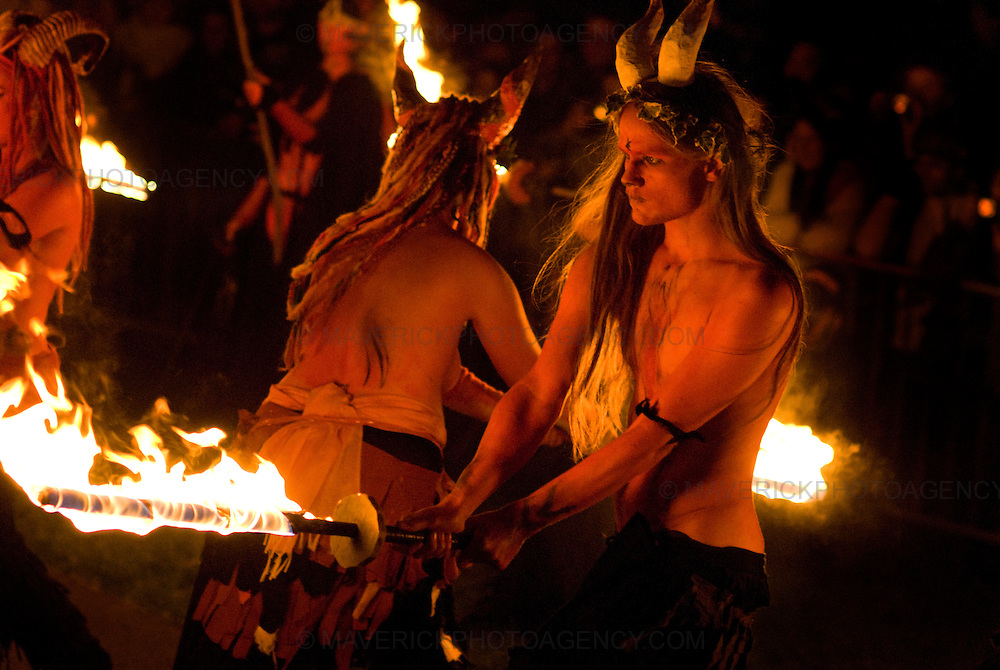
These practices were dying out by the late 19th century and folklorists did what they could to collect historical information about them. During the second half of the 20th century there was a revival of interest fostered by neo-pagans and wiccans. Wicca has tended to be syncretistic, but there are Celtic reconstructionists who are trying to restore what can be known of authentic Beltane practices.

Since 1988, a Beltane Fire Festival has been held every year during the night of April 30 on Calton Hill in Edinburgh, Scotland. While inspired by traditional Beltane, this festival is a modern arts and cultural event which incorporates myth and drama from a variety of world cultures. The two principal figures in the Edinburgh festival are the May Queen and the Green Man. The idea is that the coupling of the virgin maiden with the vegetation man will ensure fertility. We should note that the Green Man is a 20th century name given to the vegetation man whose face appeared on medieval church buildings. See “Frank Answer About the Green Man and Friends.”

The men of the village cross dressed as women and went out to find a maiden to proclaim as Queen of the May. They clothed the maiden in a white dress (for purity or virginity) and decked her out with flowers and garlands and brought her back to the village as the May Queen. The folklorist James George Frazer, in The Golden Bough, speculated that the figure of the May Queen was linked to ancient tree worship. This would make sense of the marriage of the May Queen with the Green Man.
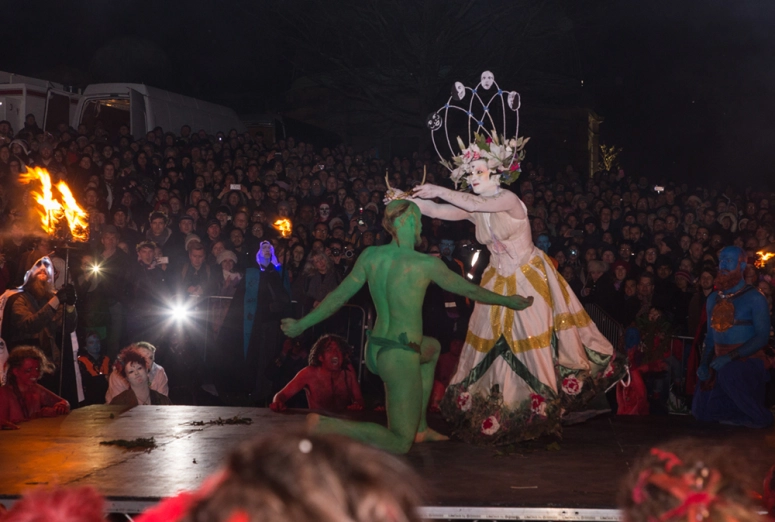
The “climax” of Beltane is what one would expect in all fertility festivals: the marriage of the god and goddess, in this case the Green Man and the May Queen. The offspring from this sexual union is a renewed Earth. This symbolic rite as part of the Beltane Festival is a moment of sacred sex; an acknowledgment that the Earth is again renewed through the two polarities of male and female. The whole festival — dancing around the fire and all that follows on the next day — is overtly sexual. It is what social historian Edward Muir categorized as a festival of the lower body (see Ritual in Early Modern Europe [Cambridge University Press, 1997, pp.93–94]).
Each With His Bonny Lass
Since Beltane is a fertility festival, it’s not surprising that humans got into the act of experiencing their own fertility. May 1 was a popular day for betrothals. Couples who intended to marry would have their hands tied together in a rite called Handfasting (“tying the knot”). Handfasting or not, both young and old went A-Maying. Couples spent the night in the woods and fields, made love like the Green Man and the May Queen, and brought back armfuls of the first May or hawthorn blossoms to decorate their homes and barns. Hawthorn was never brought into the home except at Beltane – at other times it was considered unlucky. Everyone was free to enact the sacred marriage, and there was an accepted tradition of Beltane babies arriving nine months later.
The sexual romping on Mayday certainly continued in the culture of Christendom. English composer Robert Morley published a book of madrigal-like part songs with fa-la-la refrains in 1596, of which the most famous is probably “Now is the Month of Maying.”
Now is the month of maying,
When merry lads are playing,
Fa la la la la la la la la,
Fa la la la la la la lah.
Each with his bonny lass
Upon the greeny grass.
Fa la la la la la la la la, etc…The Spring, clad all in gladness,
Doth laugh at Winter’s sadness,
Fa la la, etc…
And to the bagpipe’s sound
The nymphs tread out their ground.
Fa la la, etc…Fie then! why sit we musing,
Youth’s sweet delight refusing?
Fa la la, etc…
Say, dainty nymphs, and speak,
Shall we play barley break?
Fa la la etc…

Washing in the Morning Dew
Water as well as fire rites were observed in connection with Beltane. Women especially would visit holy wells to pray for health while walking sunwise (moving from east to west) around the well. The first water drawn from a well on Beltane Day was seen as being especially potent. Those who dipped from water would leave coins in the well.
At dawn on Beltane, maidens would roll in the dew or wash their faces with it. Dew drops would be collected in a jar, left in the sunlight, and then filtered. The dew was thought to increase sexual attractiveness, maintain youthfulness, and help clear up skin blemishes.
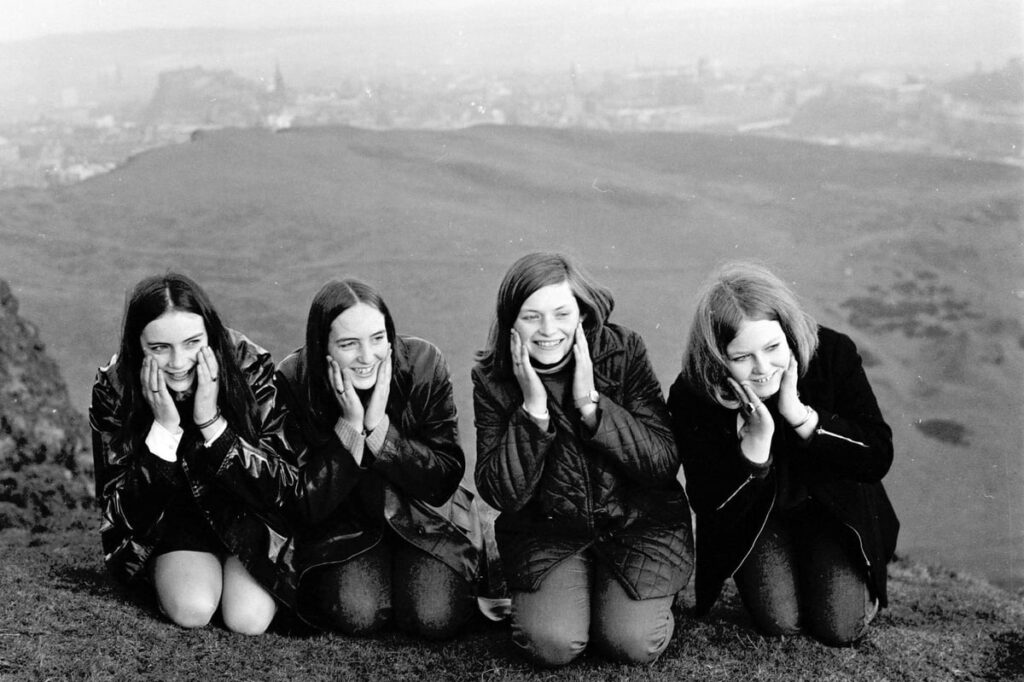
Jumping Off Magdalen College Bridge
Another wet experience is the tradition of students jumping off the Magdalen College Bridge in Oxford on May 1. The special observance of May 1 in Oxford begins at 6 am with the Magdalen College Choir singing an ecclesiastical hymn from the top of Magdalen Tower, a tradition going back more than 500 years. The choir also sings the madrigal-like part song, “Now is the Month of Maying,” following prayers for the city led by the Dean of Divinity. Large crowds of both students and Oxford residents normally gather under the tower, along the High Street and on Magdalen Bridge, where it has been a custom for Magdalen students to jump off the bridge into the Charwell River. In some recent years the river was so low that serious accidents occurred. Authorities prohibited the jumping when the river was low. But when the waters are high, the jumping by the irrepressible students resumes. What the exact symbolic meaning of this event is remains elusive.

For several hours in the morning there is general revelry, dancing, and impromptu music in Radcliff Square between the University Church and the Radcliff Camera. This would be a survival of the carnivalesque atmosphere of May Day that included dancing, games, sports, food and alcoholic beverages.
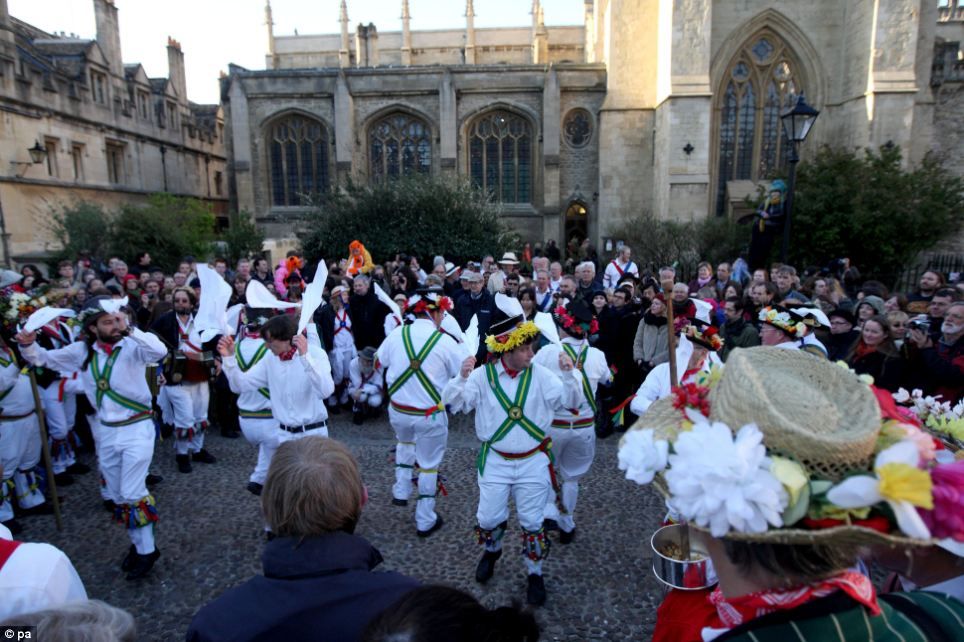
The Maypole Dance
The Maypole Dance has been incorporated into the day of Beltane. The tradition of the Maypole itself comes from Germany, perhaps reflecting the German pre-Christian veneration of trees (e.g. ash, oak). It spread throughout Europe, including to Britain and Scandinavia. In Sweden and Finland the Maipole with a cross beam is erected on Midsommardag (Midsummer Day) on June 24 (which is the Nativity of St. John the Baptist in the Christian calendar) in close proximity to the summer solstice. St. John Bonfires are also burned on the Eve of June 24.
The Beltane maypole is constructed from a straight log that is festooned with flowers. The town or village often paid for the Maypole and sometimes it was a permanent fixture. Ribbons are attached to it and the dancers, often in pairs of boys and girls, circle the pole unwinding the ribbons and then reverse direction and rewind the ribbons. One could read a fertility aspect to the dance if the pole is regarded as a phallic symbol. Its many colored ribbons and the ensuing weaving dance symbolize the spiral of Life.
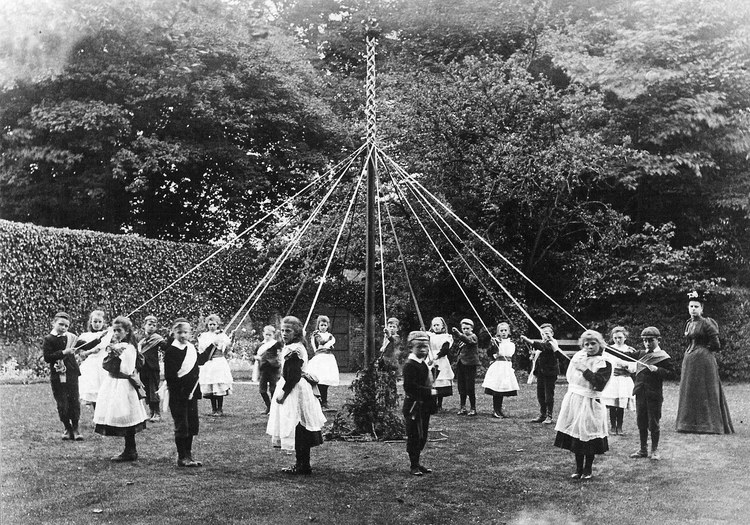
So here in these customs is a blend of sacred and profane, Christian and pagan, religious and secular customs surrounding the celebration of spring and nature and fertility on or close to May 1. There was definitely overlap because the visages of the green man in European folklore are found preserved on hundreds of medieval church buildings, along with other fertility figures such as Sheela na gig. The neo-pagans, like the ancient pagans, celebrate sexuality. In between were the Christians who could be as earthy as anyone. Beltane and the Maypole encouraged human fertility as well as the fertility of crops and livestock.
Is there a place for homosexuality in this fertility cult?
Beltane, with its fertility emphasis, is pretty heterosexual. It’s about reproduction, human, animal, and plant. Hence, the coupling and even the Maypole dancers are boy/girl. However, the ancient Celts made space for homosexual expressions. This would be typical of a warrior society that promoted male bonding. Also, letting the boys have sex with one another helped to keep them off the girls and ensure virgin brides. Even after marriage men sometimes slept with other men. Not every bonny lass was going to get pregnant on Beltane night since a woman’s period of ferility comes once a month. Much of the sexual activity is an expression of desire and the pleasures of sex. The boys could experience and model this in a time of low libido among heterosexuals. Below is a man-witch.

At a time of Wicca, there are also female witches. Wicca itself has made a place for LGBTQ participation and is regarded by many as queer in itself.
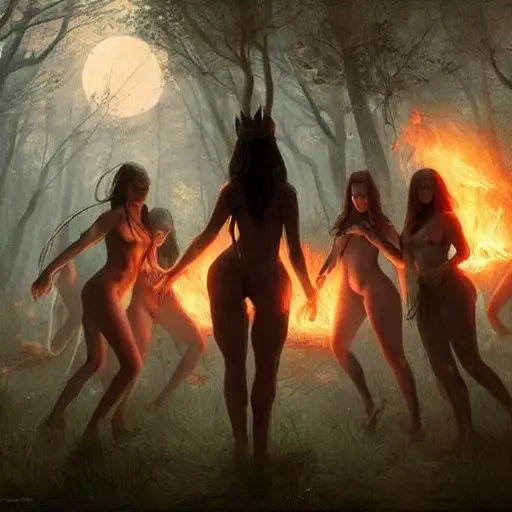
Beltane in a time of low fertility
Nevertheless, Beltane is primordially about fertility and its revival might put ideas into the heads of young adults in the U.K., Europe, and the U.S. about reversing our declining birth rates. Many young adults have gone without sex for long periods of time. exacerbated by the COVID pandemic. Their anxieties have apparently not been good for the libido and it is clear that there will be no baby boom as a result of the lock down of pandemic with its social mitigations. Procreation is needed for the flourishing of our societies. Perhaps we need more merry lads and bonny lasses on the grass during the month of Maying.
Pastor Frank Senn


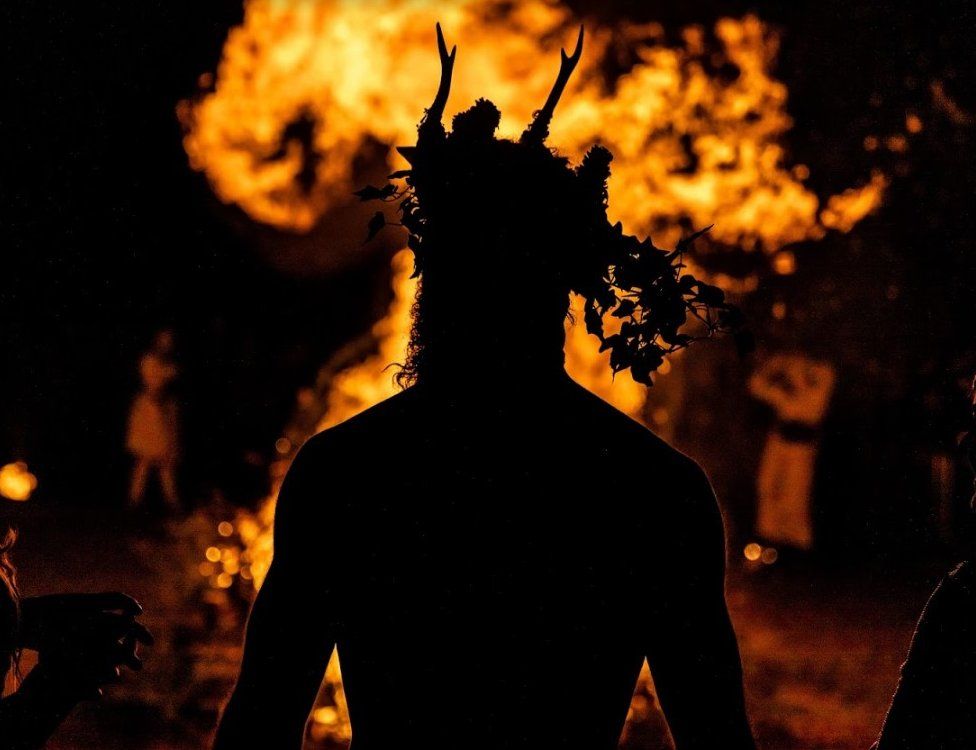

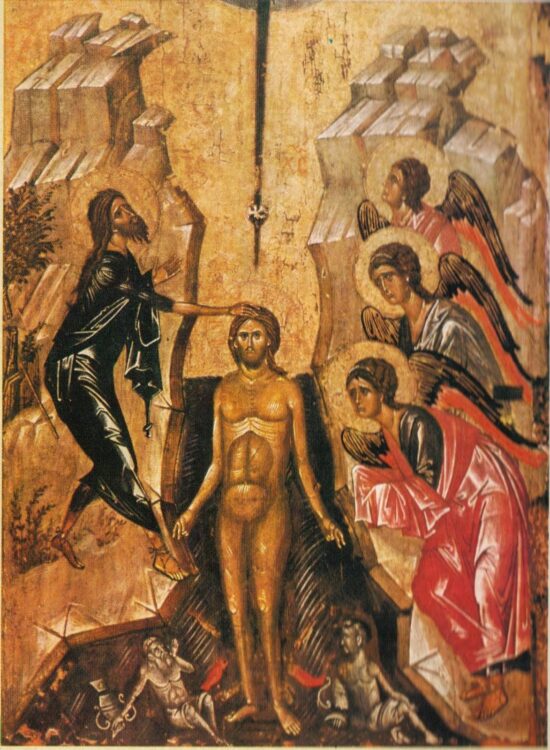


Again, your research is quite thorough. I had never heard of Beltane, but I had seen Maypole activities, never really knowing or giving thought to it’s origins.